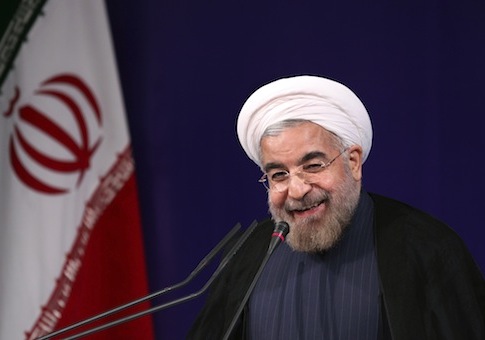Iran is on course to test around 1,000 new advanced uranium enrichment centrifuges, renewing concerns that Tehran is quietly marching toward a nuclear weapon as the West turns its eye to Syria, according to a report released Wednesday by the United Nations’ top nuclear watchdog.
Tehran has not slowed down its nuclear pursuit, but has been careful about crossing so called "red lines" established by Israel and other Western nations, according to the International Atomic Energy Agency’s (IAEA) most recent report.
The IAEA confirmed reports that Iran has begun installing more than 1,000 IR-2m centrifuges, which are more modern and quicker than older models used at the Natanz Fuel Enrichment Plant.
Iran is on pace to achieve what experts have called a "critical capability" by mid-2014 or even sooner, according to the Institute for Science and International Security (ISIS), a nonpartisan nuclear research group.
The findings come on the heels of at least 10 failed rounds nuclear talks between Iran and the West. The talks are scheduled to resume in late September, after a likely military strike in Syria, where Tehran has thrown its support behind embattled President Bashar al-Assad.
Nuclear experts say the IAEA’s findings provide proof that newly elected Iranian President Hassan Rowhani has no intention of halting the country’s nuclear program despite diplomatic overtures to the West.
The advanced centrifuges have allowed Iran to more swiftly enrich uranium, the key component in a nuclear bomb, without being detected, according to the IAEA and independent experts.
This means that Iran could "produce enough weapon-grade uranium for a nuclear weapon before inspectors could detect the breakout," according to ISIS.
Iran has also installed nearly 2,000 less advanced IR-1 centrifuges at Natanz in addition to the 1,000 advanced centrifuges, significantly increasing the nuclear plant’s output, according to the IAEA.
"Iran has not suspended its enrichment related activities," the IAEA concluded.
It also continues to hide and obfuscate information about its enrichment activities, declining to provide the IAEA with detailed information on its enrichment plans, which Iran claims are for peaceful purposes.
"Iran has not provided a substantive response to agency requests for design information in relation to announcements made by Iran concerning the construction of ten new uranium enrichment facilities, the sites for five of which, according to Iran, have been decided," the IAEA reported.
"As a result of Iran’s lack of cooperation on those issues, the agency is unable to verify and report fully on these matters," the report states.
The IAEA said that it remains concerned "about the possible existence in Iran of undisclosed nuclear related activities involving military related organizations, including activities related to the development of a nuclear payload for a missile."
Iran "has dismissed the agency’s concerns," according to the report.
Watchdog groups like ISIS and United Against Nuclear Iran (UANI) say Iran is hiding information in order to hide evidence of its nuclear weapons work.
"Iran continues to refuse to cooperate with the IAEA on the possible military dimensions of its past and possibly on-going nuclear program," ISIS wrote on Wednesday following the IAEA’s report. Iran "should address the IAEA’s concerns about its suspected past and possibly ongoing work on nuclear weaponization."
UANI spokesman Nathan Carleton said the IAEA report provides clear proof that Iran is taking great steps forward on the nuclear front.
"Unsurprisingly, this report shows that Iran’s nuclear program keeps advancing," Carleton told the Washington Free beacon. "The recent political changes in the country have not changed that trajectory, nor should anyone expect them to."
Iran remains committed to its nuclear program despite the election of Rowhani, Careton said.
"The same regime is still in charge, and the international community must not fall for a Rowhani-led charm offensive while the centrifuges keep spinning," he said. "Now is the time for the U.S. and its allies to ratchet up the pressure on Iran."
Highly enriched uranium is not Iran’s only route to the bomb, according to the IAEA, which found that construction has continued on a heavy water reactor that could produce plutonium.
"Contrary to the relevant resolutions of the Board of Governors and the Security Council, Iran has not suspended work on all heavy water related projects, including, at Arak, the ongoing construction of the Iran Nuclear Research Reactor… and the production of heavy water at the Heavy Water Production Plant," the report found.
However, construction on this heavy water reactor facility has significantly slowed down, according to the report.
Emanuele Ottolenghi, an expert on Iran and energy issues with Foundation for Defense of Democracies, said the IAEA’s report "offers no basis for optimism."
"In particular, it is clear that Iran's ability to enrich remains constant even while it is introducing new generation carbon-fiber based centrifuges at its enrichment facilities," Ottolenghi told the Free Beacon.
The advanced centrifuges will likely allow "Iran to rapidly increase its enrichment rate," he said.
"More worryingly," Ottolenghi said, is that "Iran continues to stall on the suspected military dimensions of its program and its obligations to prove its compliance with [Non-proliferation Treaty] obligations through transparency."
Ottolenghi also cast doubt on the notion that Rowhani’s election would signal a sea change in Tehran.
"Any glimmer of hope that a new government in Tehran could somehow signal a new era of moderation in the nuclear realm is undermined by the depressing evidence that continues to emerge in the IAEA's quarterly reports," he said.
